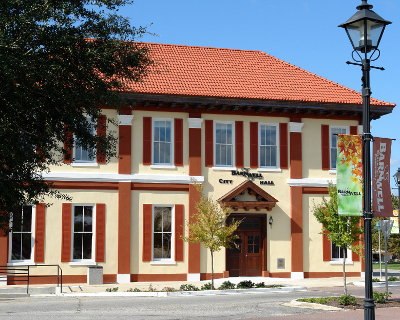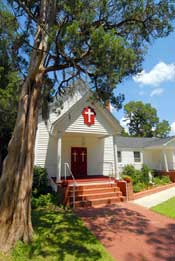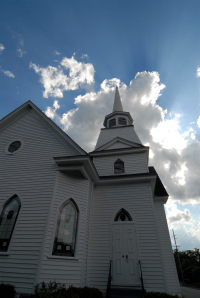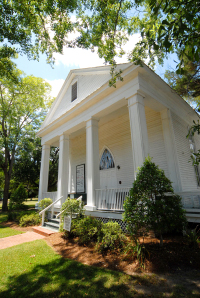City Hall / Bank Of Barnwell
 Circa 1887
Circa 1887
130 Main Street
Barnwell, S. C. 29812
The Bank of Barnwell was established in 1887 and a two story brick building was erected to house the bank that year. In 1909, the Bank of Barnwell merged with several other banks in Aiken and Barnwell Counties with the Western Carolina Bank. This bank was the last bank to survive following the Crash of '29. But in 1932, it closed and local citizens bought the bank and assets to establish the new Bank of Barnwell. The property was added to and renovated in the 1950s and again in the 1960s. A merger of the Bank of Barnwell and the State Bank & Trust was completed in 1963. From 1982 to 1996 the bank changed hands with a number of mergers, finally settling to First Citizens Bank. First Citizens built a new bank in 2003 out on Dunbarton Boulevard. The downtown bank building stood empty for several years. In 2008-09, the bank building was bought and renovated by the City of Barnwell. The first floor is used as City Hall while the second story is leased to several offices.
In the early 1900s, Edgar A. Brown established his law office on the second story of the building. To this day, his later partners continue to utilize this space for their law practice, and his original office at the corner of the building is used for a conference room for the practice.
Barnwell County Court House
 Circa 1879
Circa 1879
141 Main Street/57 Wall Street
Barnwell, South Carolina 29812
From the records in A Survey of Historical Sites in the Lower Savannah Region:
The original Barnwell (Winton) court records, bound in a unique, shingle-bound manuscript, are preserved in the Barnwell County Archives and date back to 1786. Court was originally held in private homes on plantations. The first courthouse had been built by August 3, 1879, in the Boiling Springs section on three acres of land given by Thomas Wyld and John Mitchell. In 1791 the county seat was moved to Barnwell Village. Court was held here at the house of Benjamin Odom, Sr. In 1799, Benjamin Odom donated five acres of land to the State of South Carolina for the site of a courthouse, which is the present location. The courthouse was built in 1800, but it was a wooden structure of poor quality. Another building was built in 1819, and the original one was torn down. A new courthouse was occupied by 1848. In February 1865, General Kilpatrick's Union Calvary burned the village and the courthouse. Immediately after destruction of the courthouse, money was allocated for a temporary jail, and court was held in the Presbyterian Church until 1869, when the county seat was changed to Blackville by an act of the Reconstruction Legislature. Court was held in Blackville 1869-1873. It was returned to Barnwell by legislative ordered referendum in 1874. The final action was taken in May 1875 by public vote. In 1878 the contract was let to J. Whilden Woodward and associates, J. H. Woodward and W. T. Blanton; and the final cost amounted to $16,719.45. The jail was completed in October 1878, and the courthouse was completed in February 1879. The present courthouse building was the fourth building located on the grounds given by Benjamin Odom, Sr.
A fire-proof repository for records was added in 1902 by John Eve, a renown contractor and brick mason of Barnwell. In 1921 another fire-proof addition was added for the records of the probate judge. In the 1930's the red brick building was plastered over by the WPA which is the white building of this day.
THE SUNDIAL
 In Historic Barnwell,
In Historic Barnwell,
South Carolina
The sundial is a unique vertical monument placed in front of the courthouse of Barnwell County. It was given to Barnwell in 1858 by Joseph D. Allen, at the time a state senator from Barnwell. It is thought to be the only free-standing, vertical sundial in the country. The sundial keeps almost perfect standard time, although standard time was not set up until 1884.
Captain Allen, a wealthy Barnwell resident, had the sundial made by D.B. Haselton, Ironmonger of Charleston. He was a lover of monuments and adorned his parent's graves with ornate monument. He saw to it that his Nannie's grave (Bethlehem Cemetery), and even his dog's grave, were well marked. It is ironic then, that after losing his wealth in the Civil War, he was buried in a grave not even marked by a headstone, which has now been marked by the Masons (Baptist Church Cemetery, corner of Dunbarton & Jackson Streets).
Saint Andrew's Catholic Church
 Circa 1831
Circa 1831
110 Madison Street
Barnwell, South Carolina 29812
Saint Andrew's Chapel is the earliest religious structure in Barnwell. It is also the oldest original Catholic Church in South Carolina. The Chapel was built in 1831, just ten years after the Church in the Carolinas and Georgia had its first Bishop. The first Priest to care for the Catholics of Barnwell came from Augusta, Ga. In 1847, Father John O'Connell began a monthly Mass to the parish. The church building was spared by Sherman's Army during his sweep through the area. In 1930 the Redemptory priests began their missionary work at St. Andrew's. Then in 1944, Saint Andrew the Apostle Catholic Church at Barnwell was made a memorial Shrine. The church began to grow in the early 1950's with the beginning of the Savannah River Plant, and some changes to the building were made. A social hall was added and stained glass windows were installed. These stained glass windows were originally in the old Ursuline convent of St. Peter's Catholic Church in Columbia, S.C. The church building is surrounded by a cemetery in which many names rich in South Carolina history can be found, such as Adrich, Bellinger, Maher and Simms. In more recent times a home for the Priest was built along with the purchase of another house and property adjoining the churchyard.
The Church of the Holy Apostles, The Anglican Diocese of South Carolina
 Circa 1848
Circa 1848
9457 Patterson Street
Barnwell, South Carolina 29812
The congregation was organized November 18, 1848, and the building was erected in 1856-57, and dedicated on March 11, 1857. The Rev. Edwin A. Wagner, an Englishman was the first rector, and he gave the lot and much of the money for construction of the church. The Rev. Wagner built the house located on the west side of the church, next to the cemetery, as his private residence. This house was never church property until recent years.
The church was begun with 35 white and 10 Negro members. It contained a slave gallery which now serves as a balcony.
The War Between the States left the church in disrepair. General Kilpatrick's horses were stabled in the church and watered from the fount.
In 1883, the church was restored and regular services began again with the Rev. Robert Barnwell as rector.
There are many famous men and women buried in the churchyard, including Gen. Johnson Hagood, William Gilmore Simms, Jr., Dr. A Bethune Patterson, physician and one-time state senator from Barnwell County, and Congressman James O'H. Patterson. The marker for Charlotte, a devoted Patterson family slave, can still be found here. The certificate can be seen in the church along with the original parish register and other historic documents.
The church was placed on the National Register of Historic Sites in South Carolina in 1972.
Bethlehem Baptist Church
 Circa 1899
Circa 1899
177 Wall Street
Barnwell, South Carolina 29812
This church was officially organized in 1868, having its origin in the antebellum Barnwell Baptist Church, which was built on this site in 1829. The Barnwell Baptist Church had their services on this site until 1854 when the congregation built another church building on a different site in the town. At this time several Free Blacks and slaves were members of Barnwell Baptist Church, and they asked to use the 1829 sanctuary for worship services and meetings. Permission was granted to the group, and they met there informally until their official organization in 1868. The old Barnwell Baptist Church sanctuary continued to serve this newly organized church until the building was demolished in 1898. At the time it was demolished some of the material was salvaged and utilized in the present Bethlehem Baptist Church building.
Barnwell United Methodist Church
Circa 1885
236 Main Street
Barnwell, South Carolina 29812

The village of Barnwell and the area around it had Methodists living here before the present Barnwell church was formed. There were some twenty Methodists in Barnwell Village before the War Between the States.
The present Methodist Church was organized in Barnwell 1885. The Reverend J.L. Tillman, an evangelist, came to Barnwell and held meetings in the courthouse to overflow crowds. Rev. Tillman, a Methodist, started the church by the enrollment of twenty members at this meeting.
A lot, centrally located in the town, was donated by a generous fellow townsman, Charles Pechmann, a German Lutheran, as a site for a Methodist church. The Presbyterians offered temporary use of their building while the Methodists were building their church.
The church building was completed in 1887, first being of wood and in the shape of a "T" to honor the Rev. Tillman.
In 1927-28, remodeling of the wooden church began. All of the exterior was bricked. A Pilsner pipe organ, with 40 pipes, was installed behind the choir loft.
The year 1956 saw the construction of a separate educational building consisting of an assembly hall, kitchen and Sunday School rooms. The building was named for Rev. Bryan Crenshaw, who served the church for five years in the 1950's.
In 1978, three Main Street buildings were acquired. These located adjacent to the church. Two were torn down and the third was remodeled for the Activity and Youth Building.
In the late 1980's, a second floor was added to the Crenshaw building. It contains a choir room, classrooms and the church offices. In September, 1988, the church dedicated the new Stained Glass Windows, designed by Beverly Hebbard, a local artist.
Barnwell Court House/Presbyterian Church/Performing Arts Center
Circa 1840
325 Academy Street
Barnwell, South Carolina 29812
 In the early 1840's, Dr. James Thornwell was sent by the Charleston Presbytery to organize a church at Boiling Springs. There soon was an opening for Presbyterianism in a little settlement on Turkey Creek known as Barnwell Court House. The Boiling Springs Church started an outpost here and the Reverend Samuel H. Hay was called as its first pastor with "preaching' in the Barnwell Court House.
In the early 1840's, Dr. James Thornwell was sent by the Charleston Presbytery to organize a church at Boiling Springs. There soon was an opening for Presbyterianism in a little settlement on Turkey Creek known as Barnwell Court House. The Boiling Springs Church started an outpost here and the Reverend Samuel H. Hay was called as its first pastor with "preaching' in the Barnwell Court House.
As this center of church life grew, a Presbyterian church building was erected on the southeast corner of Washington and Franklin Streets. Mr. Edwin Augustus Hagood and Dr. James O'Hear Hagood gave the land with a specification that there would be no burial of members on the property. The lumber was cut from the old Short Staple farm of Mr. Hagood and was sawed at the famous Hagood Mill. The heart of pine timbers were put together with wooden pegs. The outside door on the left opened to a stairway leading to the slave balcony. The pulpit was raised very high in order to reach this gallery where slaves from the plantations of the Gantts, Hays, and Hagoods worshipped.
After Sherman's "vandals," on their march from Savannah to Columbia, burned most of the dwellings in Barnwell including the court house, the sanctuary was converted into a court house and continued to be used as such until 1880 when a new court house was completed.
In 1891, lightning completely destroyed the steeple severly damaging the building. The steeple was never replaced and the church fell into a state of disrepair making it impossible for services to be held there. Instead meetings took place in the homes of members. In the late 1930's, the building was renovated and bi-monthly services were held in the church.
With the development of the Savannah River Project in the 1950's, the church saw tremendous growth. Barnwell Presbyterians began calling their first full-time pastors. In 1967, members signed a contract for construction of a new sanctuary to be built on the site of the historic church. At this time the Presbyterians gave the church building to The Barnwell County Historical Commission and it was moved to its present location on Academy Street where it is used today as a center for the performing arts (The Circle Theatre). The building is listed on The National Register of Historic Places.
Tours of Barnwell
We have self-guided tour books available.
